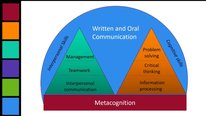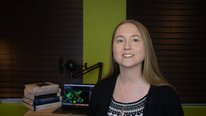- Andrea Greenhoot
- https://psych.ku.edu/andrea-follmer-greenhoot
- Director/Professor
- Presenter’s NSFRESOURCECENTERS
- University of Kansas
- Caroline Bennett
- John E. & Winifred E. Sharp Associate Professor
- Presenter’s NSFRESOURCECENTERS
- University of Kansas
- Mark Mort
- Professor and Director of Undergraduate Biology
- Presenter’s NSFRESOURCECENTERS
- University of Kansas
- Blair Schneider
- Postdoctoral Researcher
- Presenter’s NSFRESOURCECENTERS
- University of Kansas
Choice
TRESTLE
NSF Awards: 1525775, 1525331, 1525345
2019 (see original presentation & discussion)
Undergraduate
Widespread implementation of effective and inclusive STEM teaching strategies in undergraduate education remains an elusive goal, in part due to the lack of a practical model of educational transformation and faculty development that is sensitive to faculty needs, and can be adapted to different institutional contexts. This video describes a multi-university initiative, "TRESTLE," that is designed to address this gap. The TRESTLE model combines department-embedded expertise, intellectual community building, and accessible, visible evidence of the impact on student learning to support the transformation of undergraduate STEM courses and foster scalable change in faculty teaching behavior, attitudes and culture. The ultimate goal is to improve learning and success for all students in STEM. The video will share what we are learning about how these strategies can be localized to different institutional contexts, and how others can join the TRESTLE network.
Related Content for TRESTLE: A Network Approach to Improving STEM Education
-
 2021POGIL and The POGIL Project
2021POGIL and The POGIL Project
Rick Moog
-
 2021IBL Workshops Work!
2021IBL Workshops Work!
Stan Yoshinobu
-
 2018How Can We Help Students Succeed in College Math Courses?
2018How Can We Help Students Succeed in College Math Courses?
Stan Yoshinobu
-
 2019Discovery Process: Interdisciplinary STEM General Education
2019Discovery Process: Interdisciplinary STEM General Education
Michael Roberts
-
 2018Teaching about Earth for a Sustainable Future: The InTeGrate
2018Teaching about Earth for a Sustainable Future: The InTeGrate
Cathryn Manduca
-
 2020Enhancing Learning by Improving Process Skills in STEM
2020Enhancing Learning by Improving Process Skills in STEM
Renee Cole
-
 2021Experiment-centric Pedagogy in STEM During COVID-19 Pandemic
2021Experiment-centric Pedagogy in STEM During COVID-19 Pandemic
Oludare Owolabi
-
 2020Improving Biomolecular Visualization Instruction
2020Improving Biomolecular Visualization Instruction
Kristen Procko




Andrea Greenhoot
Director/Professor
Thank you for watching the TRESTLE video! Our video describes the common features of an intervention model that is being implemented at seven universities to promote widespread faculty adoption of teaching practices that support better and more equitable student outcomes. We are eager for questions and feedback on any aspects of our project, but are especially interested in learning what strategies you and your colleagues have found to be effective in scaling change in STEM teaching practices.
Rebecca Roberts
Fantastic project! I am especially interested in the idea of making these course changes visible. How has the project motivated other stakeholders to attend the visibility events? I am thinking about administrative folks and other faculty who may have yet to buy in to evidence-based pedagogical changes
Andrea Greenhoot
Director/Professor
Great question! Each campus is handling this differently, but there is certainly an attempt to get administrators and other faculty to attend the events. The most common strategy is to make the event celebratory (e.g., an end of year celebration of teaching or symposium) and to get it on relevant administrators' (chairs and deans, provost and chancellor) schedules as early as possible. Relatedly, we have asked administrators to make remarks at the event. Organizing the event as a reception/social event/celebration may increase the likelihood of individuals who are not involved stopping by to check things out. As far as engaging the participants, at KU, any faculty member who participates in a funded program run by our teaching center (e.g., a course design institute, faculty seminar, or small grant for course transformation) is expected to produce and present a poster on their work at our end of year event. We then assign a graduate student fellow from the center to help the faculty member produce the poster. This ensures that we have a lot of work represented at the event, and many of those faculty will encourage their colleagues to attend.
Rebecca Roberts
Jonathan Margolin
I see how building a network of districts makes this work more sustainable. I am wondering--to what extent and in what ways are individual districts, and the network as a whole, engaged in continuous improvement of their courses?
Andrea Greenhoot
Director/Professor
A model of continuous improvement of courses, and student learning, underlies all of the course transformation work that TRESTLE is designed to promote on the university campuses, as shown in this model of the process led by the embedded experts: https://trestlenetwork.ku.edu/resources/ We hope that by changing the way faculty and departments view the process of teaching (in line with that model) it will help sustain the work beyond the period of the grant, but that is what we will be assessing over the next year and a half.
Alex Rudolph
Professor
Very nice video! I like the way you used graphical representations of your work rather than talking heads to explain the project. It sounds like your model is having an impact in the universities in your consortium and is successfully transforming a large number of courses. I have a couple of questions:
1) What are your plans to engage the rest of the faculty at each university? As someone who has worked for many years trying to bring about similar adoption of evidence-based teaching practices at my own and other universities, I find that the main challenge to systemic and cultural change is the resistance of the majority of faculty in the university who don't see any need to change.
2) Related to question 1, how are the administrations of the TRESTLE university engaged in this work? It seems to me that true systemic change will require additional resources and rewards for faculty who make these changes, as you correctly mention early in your video, especially after the grant funding ends.
Patricia Marsteller
Assoc Dean and Professor of Practice
Wow. Alex just channelled me. But in addition to his kudos and questions...Have you seen the Science Education Initiative on line book
https://pressbooks.bccampus.ca/seihandbook
Some of it may be helpful in thinking about scale.
I'd love to hear about any rewars and incentives that may be part of your approach.
Andrea Greenhoot
Director/Professor
Thank you Patricia for providing the link to the SEI handbook! Yes, the authors of the SEI book are the leads at two of the TRESTLE partner institutions (Stephanie Chasteen from the University of Colorado Boulder and Warren Code from the University of British Columbia). The initiatives being implemented on the TRESTLE campuses are designed with many of the lessons shared in the handbook in mind. It's a terrific resource to guide the implementation of a program organized around embedded experts. TRESTLE is experimenting with different forms of expertise, and with strategies to do more with fewer embedded experts. UBC has continued to run its original SEI program and is serving as a comparative institution for the other 6 campus adaptations.
Patricia Marsteller
Andrea Greenhoot
Director/Professor
To broaden faculty participation, we're working at a couple of levels. First, the department-level focus is a key part of our approach- many departments are using strategies to broaden engagement within departments such as:
The emphases on cross-department community building and making results visible are part of the effort to expand engagement beyond the targeted departments. For instance, after seeing the potential of a teaching postdoctoral fellow in physics, Queen's University invested in hiring more fellows into two other departments to expand the initiative's reach. Other campuses have invested in related programs that bring others on board, such as mini grants for course transformation, faculty learning communities, or undergraduate Learning Assistant programs. Campuses are also working to create synergies with other initiatives that connect to and reinforce work on course transformation. For instance:
Administrator Support-- There is some variation across the campuses in the involvement/support of the university administrations and in the type of unit that is the platform for the initiative, and this is likely to be an area in which we will learn a lot. The NSF funding and especially the cross-university network (being able to say that peer universities are doing this with us) seem to help us get attention and support from administrators, but we think it will be important for us to be able to generate and share results that we can leverage to get the types of institutional and administrative support that will be needed to sustain this work.
We'd love to hear what others have found to be key levers for getting administrative buy-in and support.
Patricia Marsteller
Sehoya Cotner
Excellent work and very nicely depicted...thanks for sharing!
At the University of Minnesota, we've used a "Faculty Fellows" model for involving participants in learning about, and implementing, inclusive teaching strategies into their courses. Each participant is a fellow for one year, and concludes their fellowship by presenting at a poster session. It's been very effective at transforming teaching and broadening networks around pedagogy. But we worry about sustainability when our external funding runs out. I'll take a look at your other resources for ideas!
Andrea Greenhoot
Director/Professor
Thanks for your comments Sehoya! We have a program that sounds really similar to your faculty fellows model (we call it Diversity Scholars) at the University of Kansas. I agree with your concerns about sustainability, particularly when a program is just one year. One strategy we've been trying, both through TRESTLE and our other programs, is once faculty have spent some time transforming and improving their own courses, to try to support their development as mentors or change agents who can begin to influence their colleagues and/or the broader curriculum. We are still exploring the best ways to do that though.
Patricia Marsteller
Assoc Dean and Professor of Practice
Hi Andrea
Thanks for the detailed answers. This is cool. Love the STEVAL project too. I will share with our Center for Faculty Development and Excellence and with groups that are developing ways to evaluate teaching excellence.
Stephen Alkins
Diversity, Equity, and Inclusion Officer
Great addition to Professional Development for sure!
1) Do your embedded specialists also receive training on culturally inclusive pedagogy to help teachers/instructors/professors develop more insightful curricula?
2) Similar to a question above regarding buy-in of faculty departments, has this systemic change been supported by boards of trustees? It seems that once grant funding runs out, initiatives like this will need to be part of strategic plans and supported internally.
Caroline Bennett
John E. & Winifred E. Sharp Associate Professor
Hi Stephen! Thanks for your questions. We do indeed provide training and community around topics of diversity, equity, & inclusion to support the ability of the embedded experts to work with faculty colleagues on developing their teaching with this focus in mind. Our diversity scholars program at KU helps to develop faculty members in this regard, too, and we have also found some really helpful synergies between these two groups (the diversity scholars have also helped us with the formation of the embedded experts). Regarding your question on the board of trustees (for us, Regents), they have been briefed on the work. You're 100% right that internal support is critical for sustainability of this initiative, and it has been important for us to share the "big picture" impacts of this work (student success, retention, graduation rates) with leaders within and beyond our own campus. Thanks again for the questions!
Dave Miller
Hi, and thanks for sharing your project in the Showcase. I’m curious about the administrative navigations that were likely required to bring together 7 universities. Also curious about the Bayview Alliance, and its mission - I’m sure I can search this, but I’d be curious to hear about it, here, in the forum. I’m also wondering if your Alliance has given thought to how K-12 schools, nationally, might tap into the great work that you’re doing. Thanks! - Dav
Caroline Bennett
John E. & Winifred E. Sharp Associate Professor
Hi Dave! To answer your question about the Bay View Alliance's mission, it is focused on bringing about changes in higher ed that support adoption of evidence-based teaching practices that translate to improvements in student learning. The BVA was instrumental in bringing together this group of institutions, and fostering the 'change philosophy' being studied in this project. Since 6 of the TRESTLE network institutions were already a part of the BVA, leaders from each of those campuses had been engaged in sustained discussions regarding bringing about changes in instructional practices. Regarding your question about K-12, our work and that of the BVA has been very focused on higher ed, and even a subset of higher ed - large R1 institutions. There is some advantage to keeping the focus tight, given the challenges associated with making widespread changes possible in any of one of these important arenas. It is quite possible that some of our findings from this project might be generalizable to K-12, though, and it's a thought-provoking idea. Thanks for the great questions, and for engaging in discussion! (P.S. - Here is a link to the BVA's website if you are interested in learning more: http://bayviewalliance.org/)
Patricia Marsteller
Assoc Dean and Professor of Practice
I'd love to hear more about how you plan to disseminate this super project. The embedded experts on diversity and inclusion sounds like an interesting model. Do you know if any of the HHMI Inclusive Excellence projects are taking that approach?
Mark Mort
Professor and Director of Undergraduate Biology
Hi Patricia. Thanks for your comments and questions. We have been working on multiple avenues to disseminate the work of TRESTLE. First we have established a project website (https://trestlenetwork.ku.edu) to share resources, milestones of the project, information on variation of the local embedded expert model employed by partner institutions, and various other updates. The website also highlights our ZOOM-based brown bag lunch discussions and colloquia on topics related to course transformation impacts, building community around evidence-based teaching, and many other topics. We encourage you and others to join the TRESTLE network to receive updates on opportunities to engage in a broader discussion of teaching practices.
In addition, many participants at partner institutions have presented results at national/international meetings, regularly lead workshops locally and regionally, and a series of publications are anticipated as we now enter into the data analyses phase of the project.
I am not aware of any HHMI-funding Inclusive Excellence projects that are trying to build a large support network to connect educators to resources as we are doing in our TRESLTE project, but it would be great to hear more specifically from others on the goals of their HHMI-funded projects and how TRESTLE might interface with that work.
Thanks again for checking out our project.
Further posting is closed as the event has ended.